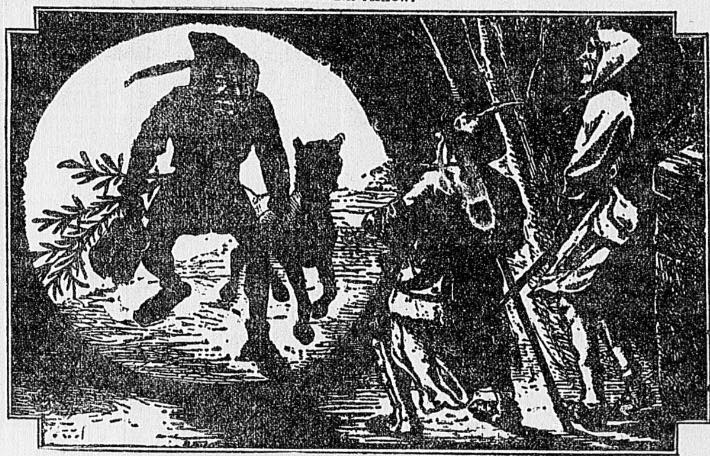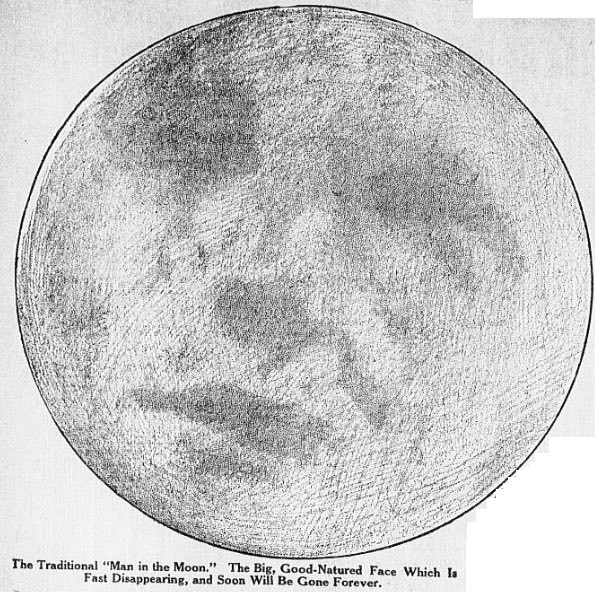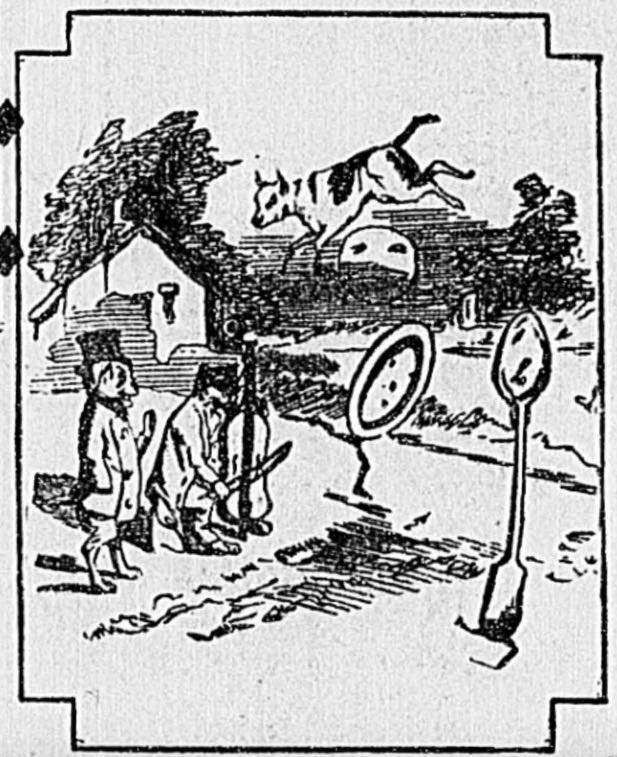
You hear very few references to the Man on the Moon these days, at least compared to when I was a kid in the 1970s. Here is an informative article found in a 1913 newspaper that touches on some of the legends about the Man in the Moon, and even gives brief mention to the Woman on the Moon.

The Man In The Moon Is Dying!
The Old Fellow Who Has Been The Source of Countless Songs, Stories and Superstitions for Ages Will Soon Have Passed Away – The Ugly Crab Is Eating Him!
OUR old friend the Man in the Moon, who has endured for countless ages , is dying. Professor J. B. Hale, who fills the chair of astronomy in King’s College, London, is authority for the statement that a great change is taking place on our satellite’s surface so that it will not be long before the familiar face that has figured in story, song, poetry, and superstition ever since man became conscious there was a moon, will soon pass away from human sight forever.
What is the Man in the Moon dying of? Old age – or, scientifically speaking, chemical disintegration of the mountains and hollows that form his face. Science tells us that the big smiling face we see when the moon is full is made up of shadows cast by the great craters and enormous hollows called the seas of the moon. The right eye of the Man in the Moon is formed by the Sea of Tranquility; the left eye by the Sea of Showers; the nose by the Sea of Clouds, and the mouth by the Sea of Humors. The crater and sea walls are crumbling, and so the shadows are changing – and so the old Man in the Moon is passing away.
His death will be a distinct loss to sentiment, tradition, literature and commerce the world over. No single cosmic phenomenon has ever figured so much in man’s more playful thought or his superstitions than the Man in the Moon. What will take his place? The answer is easy – the Crab! As the old Man dies the Crab will become steadily stronger, absorbing his fading life! But what emotional influence can future lovers, sentimentalists, poets and songwriters get from the Crab in the Moon?
When one begins to consider only a part of the vast mass of jingles and rhymes, legends of stories, songs and superstitions upon the Man in the Moon in every known tongue in every part of the earth how cataclysmal is his loss can be seen readily.

“The Man in the Moon will come down and get you if you’re not good,” mothers have told their children in every tongue for countless ages. It will mean nothing to the children of the future.
“Moon face” has its equivalent in every language.
In China from time immemorial the Man in the Moon has been believed to govern marriages and to tie together with an invisible silken cord the young men and maidens whom he designs to unite in matrimony. The Rev. Timothy Harley, one of the leaders in the English Royal Astronomical Society, says of the Chinese beliefs in his Moon Lore: “This must be the man of the honey moon, and we shall not meet his superior in any part of the world.”
In Teutonic legend, the Man in the Moon carrying a bundle of sticks on his back represents a Sabbath breaker who met a divine being while cutting wood on a sacred day. When remonstrated with he laughed, and said that Sunday and Monday were all the same to him. “Then stand in the moon for a perpetual Monday!” (Monday), was the sentence instantly pronounced.
Dante says that the Man in the Moon is Cain, banished there forever for his great sin. Some of our Indian tribes had a legend that the Man in the Moon was a hunter, condemned to the sky for some transgression; and a British Columbian clan of red skins, visited by Mr. William Duncan, told him a story of a child that cried out in the night for water, but was neglected by its mother, whereupon the Moon suddenly appeared at the door of the lodge with a pot of water which the child eagerly seized. Then the Moon carried the child up into the sky, where its face can still be seen.
The New Zealand savages affirm that the Man in the Moon is one who, going out in the night, stumbled and sprained his ankle, whereupon he cried for help and lamented so loudly that at last the Moon came down and took hold of him. In his terror the man seized a bush, but the Moon pulled it up by the roots and sailed back into the sky with both man and bush. And there you can still see his face, sometimes crying because he cannot get back and sometimes laughing because his wife can’t get to him.
Mother Goose will feel the Man in the Moon’s death keenly. Who of our many readers that will not mourn now that the subject of this rhyme is disappearing?
“The Man in the Moon came tumbling down
And asked the way to Norwich;
He went by the South and burned his mouth
While eating cold pease porridge.”
Then there is the old familiar barnyard picture of the laughing moon in the rhyme:
“Hi diddle diddle, the cat and the fiddle,
The cow jumped over the Moon”
Eliminate the many variegated pictures of the Man in the Moon from the old Mother Goose book and the loss of a great number of the old favorites is noticeable indeed.
Consider the thousands of popular songs that have been written under the theme of the Man in the Moon. To think that future song writers, if they would be at all accurate, must omit mentioning the romantic Man in the Moon is to be lamented. Bonnie Thornton’s famous hit, now almost twenty years old, must die out under the new regime. But it will not be easy to forget those lines:
“My sweetheart’s the Man in the Moon,
We’re going to be married in June, etc.”
Four years ago Andrew Mack introduced his song hit, “Go way, Mistah Moon,” in “The Prince of Bohemia,” with this chorus, which is still being sung by many:
“Oh, Mr. Moon, up in the sky,
Won’t you tell me de reason why, tell why,
You shine so bright when she and I
Would rather you would hide your head and
Let the clouds roll by!”
Then there were and are “Mr. Moon Man, Turn Off Your Light,” “If the Man in the Moon Were a Coon,” “Good Night, Mr. Moon,” “Hello, Mr. Moon Man, Hello,” “If the Moon Told All He Knew” — but the task of recording even one ten thousandth of Man in the Moon songs is too great.
Who can forget how Dickens utilized the Moon Man in one of his tenderest chapters of “Little Dorritt.”
The worship of the Man in the Moon extends into prehistoric times. In Chaldea, the principal center of moon worship, was Ur, in the land of Abraham. Some have asserted that Mount Sinai was originally consecrated to the Man in the Moon. He was the greatest divinity of the Arabs, and was one of the gods of the Persians.
The grotesque features of the satellite have played a great part in the religion of India, and in China such worship will suffer greatly when the natives discover that the face of their god has been obliterated. In ancient Egypt the Man in the Moon was considered the religious equal of the Sun.
In the rites of the Druids the Man in the Moon played a conspicuous part. There are traces of ancient moon worship still surviving in the British Isles, as well as in many parts of Europe. Among the American Indians worship of the Man in the Moon was widely spread; and this worship will probably exist, despite the actual changes of this latter day, until the last Indian is dead.

By the Aztecs the Man in the Moon was defined under the name of Meztli, and they had a pyramid of the man, as well as a pyramid of the Man in the Sun. In the temple of the Sun at Cuzco was a chapel consecrated to the moon, the deity held next in reverence to the sun, and regarded as the forefather of the Incas.
These strange spots on the moon, that have given rise to so many legends, first had their true character revealed when Galileo, in 1610, aimed his telescope at the satellite. The spots turned out to be mountains, hills and plains. “It is just like the earth,” he declared.
Thus it is seen how the passing of the Man in the Moon is of worldwide moment, how it will affect religion, astronomy, art and sentiment in every land.
But that is not all! There is a Woman in the Moon – naturally. And she is following her husband into death, as is her duty. The same changes that are killing the man in the Moon are killing his wife.
The Woman in the Moon has also been a popular subject of myth making. In truth, it would seem that her profile is almost as famous as the full features of the man. Until recently the Woman could be seen plainly at any time between the first quarter and the full moon. When the Man showed his face she modestly kept in the background. The face, which was bright, was turned eastward. The outlines of forehead, nose, mouth and chin are formed by the “Sea of Showers” and the “Sea of Clouds”; the eye is indicated by one of the small, dark, oval plains near the center of the disk, while the “Seas” of “Serenity,” “Tranquility,” “Fertility” and “Nectar” constitute the hair on the top and back of the head. The great crater ring Tyco blazes like a jewel on her bosom.
The Ugly Crab will soon have eaten them both!
Source: The Times Dispatch. Newspaper. March 23, 1913.

